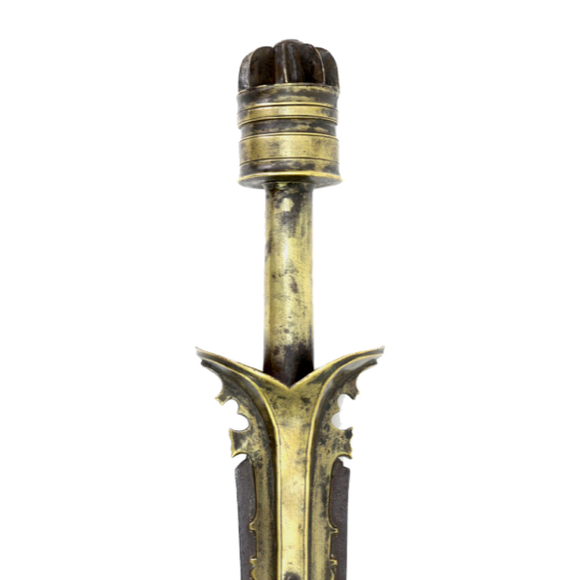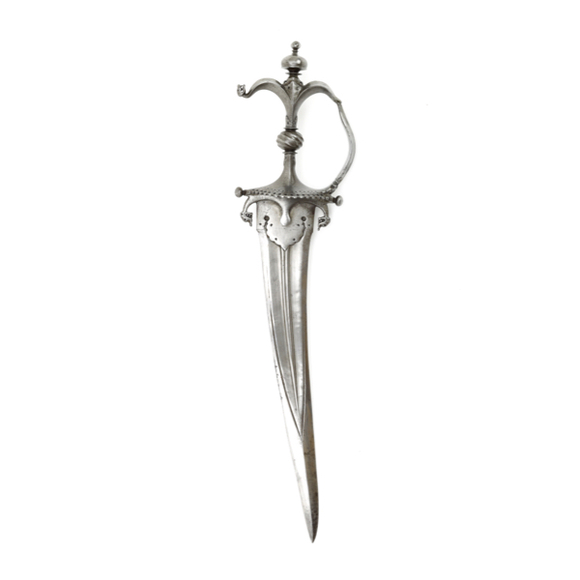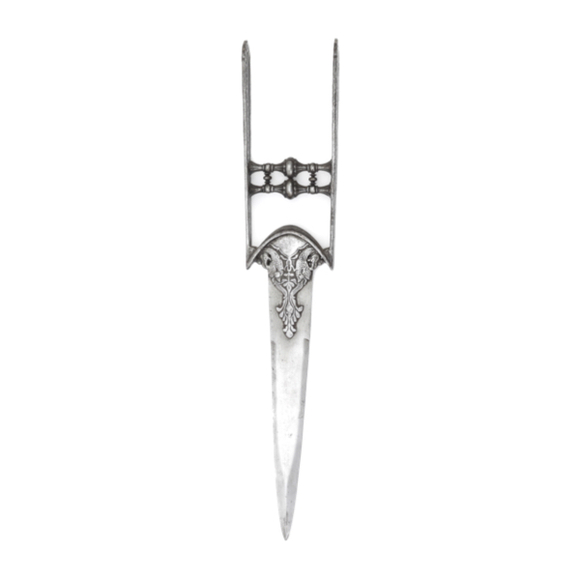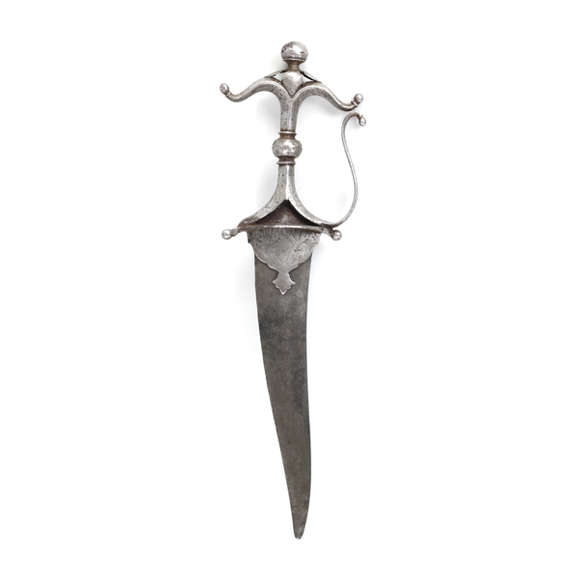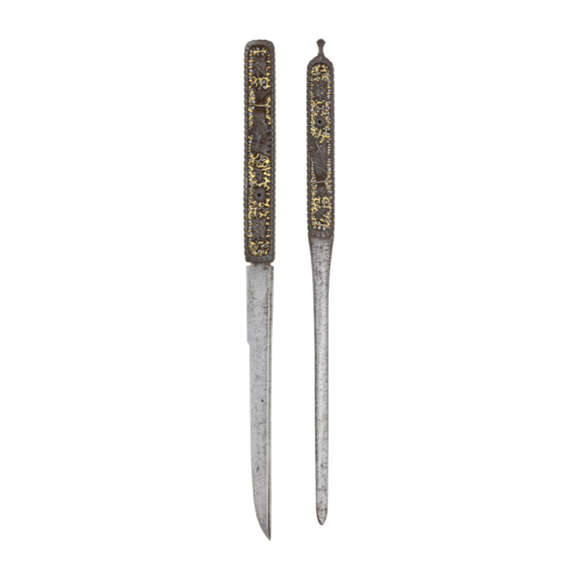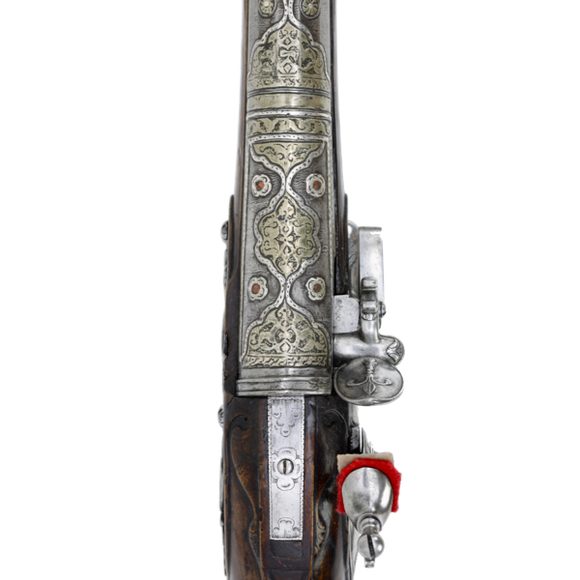An early fighting piece with strong reinforcing langet and broad, cobra shaped tip.

98 cm
88 cm
Ahead of langets 5 mm
At widest 3 mm
Base 40 mm
Widest 62 mm
1189 grams
31 cm from hilt
Wootz steel, iron, silver, red pigment
South India
17th century
UK antique art market
Introduction
This sword is known in the literature as paṭṭiśaḥ (पट्टिश) or khanda (खंडा). It is one of the oldest forms of swords in India and is already depicted in temples in Orissa from the 2nd century AD. Such swords are often depicted as being held by a deity, where they symbolize wisdom cutting through the veil of ignorance or -in the case of Durga slaying the buffalo demon- the victory of good over evil.
Sikh Guru Gobind Singh (The Sikhs' 10th Guru) used a very similar old southern pattisa to administer Amrit (holy water) to the Sikhs when he created the Khalsa in 1699. (The Khalsa is a group into which committed Sikhs can be initiated to demonstrate their devotion to their faith, symbolically giving their lives to their Guru). This pattissa is now held in reverence at Takht Kesgargh Sahib at Anandpur Sahib.
This example
The large blade with a characteristic spoonbill shape is made of very fine-grade wootz steel with the desirable boldly-contrasting patterns in shades of silver and dark grey. The blade has no obvious flaws. It is lap-welded to a base of forge folded steel.
The hilt is of typical earlier form, without the knuckle guard usually present on later examples and a slender, round cross-section grip with a thickening in the center. It has a hollow dish pommel.
The blade is held by three rivets going through thick langets of triangular cross-section, providing considerable stiffness to the construction. At their base are two upward-pointing quillons. The hand guard is oval in shape with a fold down the middle, with two notches on either side of the fold on each side.
Langets and guard are finely engraved with geometric patterns and a number of chakra. Remains of red lacquer in the crevices are indicative of ceremonial use at some point during its life.
On wootz steel
Wootz steel is a very advanced type of steel that was made in crucibles where special iron ore was heated with the leaves of certain plants. Pieces of glass were added, which after melting, floated on top of the heavier iron and seal the crucible. The leaves and ore could then undergo a chemical process without losing any elements to vapors. The resulting steel was very hard but also tough at the same time. What they didn't know then, and we do now, is that the process formed carbon nanotubes that are responsible for the special properties of this material.
Forging these wootz billets created in the crucible out to blades was very specialized work that had to be done at lower temperatures than normal iron and steel forging; otherwise, the special carbon structure could burn and go lost. Few blacksmiths could do it well, and the exact methods of working were often secrets kept within the workshop or guild.
The process made making larger swords was particularly difficult work, and so this huge blade with a very consistent pattern and no flaws in the wootz is a testament to the maker's skill.
Comparable examples
Four pattisa that bear a strong resemblance to this one were presented to Edward VII, when Prince of Wales, during his tour of India in 1875-76, by Muktamabai Chhatrapati, Princess of Tanjore. Royal Collection Trust accession numbers RCIN 37892, RCIN 37893, RCIN 38016 and RCIN 38018.
Of those, especially RCIN 37893 and RCIN 38018 come close in overall hilt form. Their original catalog note dates them to the earlier 17th century.1 Today's database says 18th century. I tend to agree with the initial dating and place the group in the 17th century.
Guru Gobind Singh for example used his pattisa when he created the Khalsa in 1699. Given the Sikhs reverence for antique arms, it may well have had some age at this point.

The pattissa of Guru Gobind Singh (1666-1708) in the center.
Photo by Kahn Singh Nabha. Published in the Mahan Kosh of 1927.
Notes
1. C. Purdon Clarke; Arms and Armour at Sandringham: The Indian Collection Presented by the Princes, Chiefs and Nobles of India ... in 1875-1876. London. W. Griggs & Son. 1910. Catalog numbers 329-330, pages 24-25.
Conclusion
A very good example of an early khanda, a type often referred to with their specific name pattisa. It features a blade made of very fine wootz, mounted on a nicely engraved hilt with remains of ceremonial lacquer.
Excellent condition for age.





























Of a style often associated with Tanjore, the seat of the Vijayanagara empire.
Somewhat worn but once very high-quality, with great sculptural qualities and remains of silver "true…
The only set of its type known to me in both private and museum collections.

